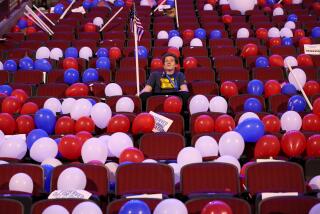Examining the Candidates
- Share via
Today is the first day of the rest of the 1988 presidential election campaign. That is an unhappy circumstance for Gary Hart, but it may be fortunate for the American people.
Now there is a seven-candidate Democratic field not dominated by a designated front-runner. And while Vice President George Bush still claims leadership of the Republican entries, that contest must be considered a volatile affair so far in advance of the Iowa caucuses, with the Iran- contra hearings set to go through the summer.
Naysayers may deplore the size of the presidential field of candidates who are not well known and who are marked, some would say, by an apparent lack of talent, experience or presidential stature.
In fact, the stunning turn of events can work to the advantage of voters and help them to make a more confident and knowledgeable choice for President in November, 1988. More candidates may come in. There is time for the candidates to make themselves known to the voters not just in Iowa and New Hampshire but throughout the country. Most of the candidates have considerable records in public service that need to be carefully examined and analyzed. There is time to have extensive debates on issues on radio and television and in the print media.
The field, in aggregate, may look bland from afar. But these men (perhaps, finally, by 1992, it will be men and women) are interesting, committed and able people. But to make this a rational campaign that allows voters to make intelligent choices, several things must happen. This is a new era with a new generation of candidates, and 1988 provides an opportunity for shucking off some of the old conventional wisdoms and assumptions that no longer are valid or useful.
For one, the political Establishment and media must resist the temptation to narrow the field too quickly and arbitrarily. There needs to be less emphasis on the horse-race aspect of the campaign. There will be tremendous pressure to weed out the also-rans on the basis of early primary results or opinion polls. Both the candidates and the outside experts need to take care in setting the assumptions and standards by which one is judged a winner or loser.
There needs to be more attention paid to issues--and not just the issues that the candidates choose to discuss, but those that most concern the people and those that are most likely to face the new President on Jan. 20, 1989. The model campaign agenda, backed by stacks of white papers, may sound impressive, but it also may have little to do with the nation’s real needs. And a candidate’s campaign promises may be meaningless unless he can also demonstrate that he has the ability to win support for his programs in Congress.
Still, the voters will make their decisions to a large extent on the basis of intangibles. These are such things as character, leadership, intellect, integrity, credibility, temper, a sense of values, a sense of humor. How are the candidates viewed by their peers? Are they respected for their fairness, judgment and honesty? How well have they done in choosing assistants? What sort of people would they appoint to important positions? How do they react under pressure and adversity? Who are their heroes that they would emulate?
Americans can never be certain that they have made the best choice for President. Beginning today, however, they can start a process that assures them on Nov. 9, 1988, that they made the best choice possible under the circumstances.
More to Read
Get the L.A. Times Politics newsletter
Deeply reported insights into legislation, politics and policy from Sacramento, Washington and beyond. In your inbox twice per week.
You may occasionally receive promotional content from the Los Angeles Times.










